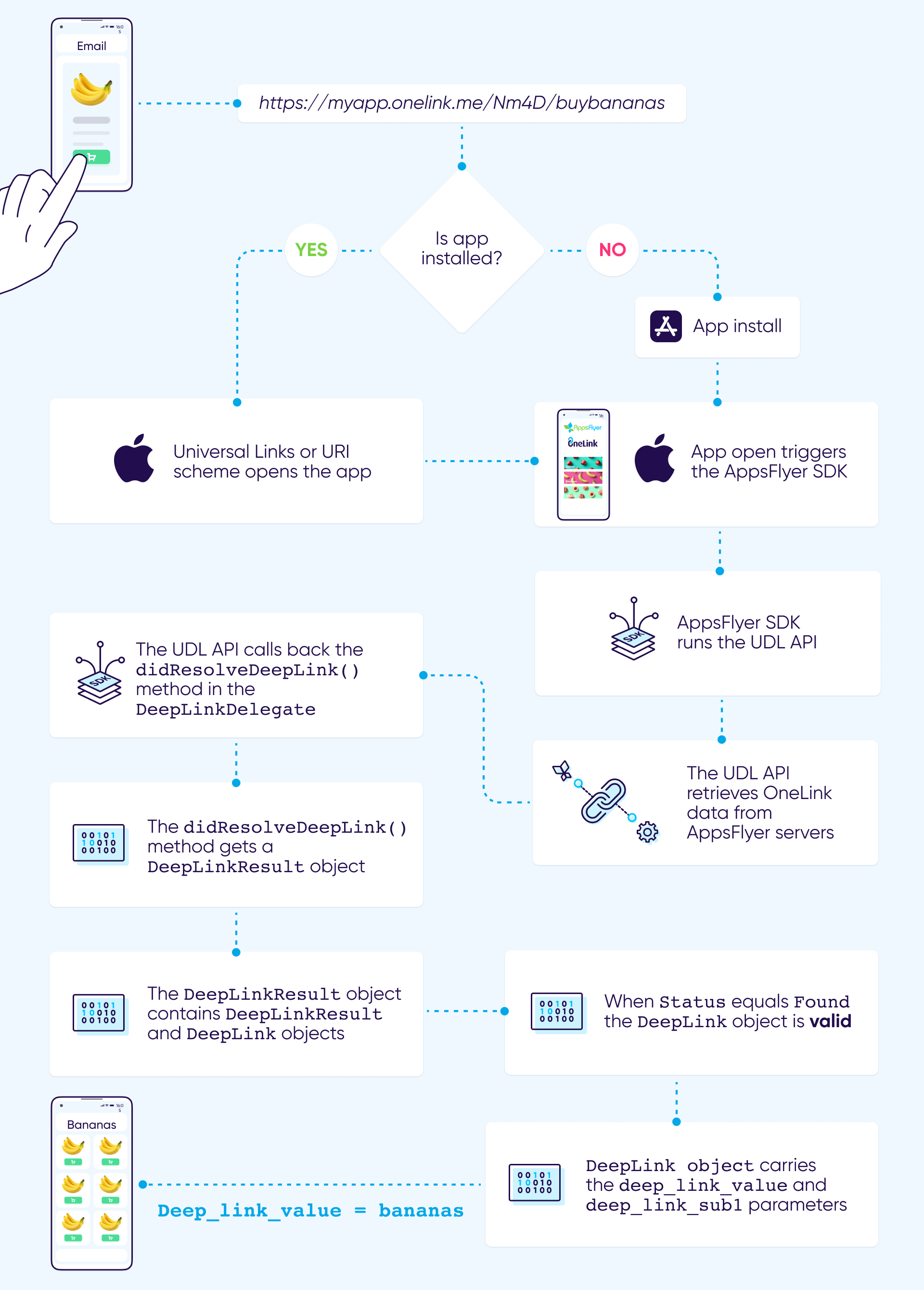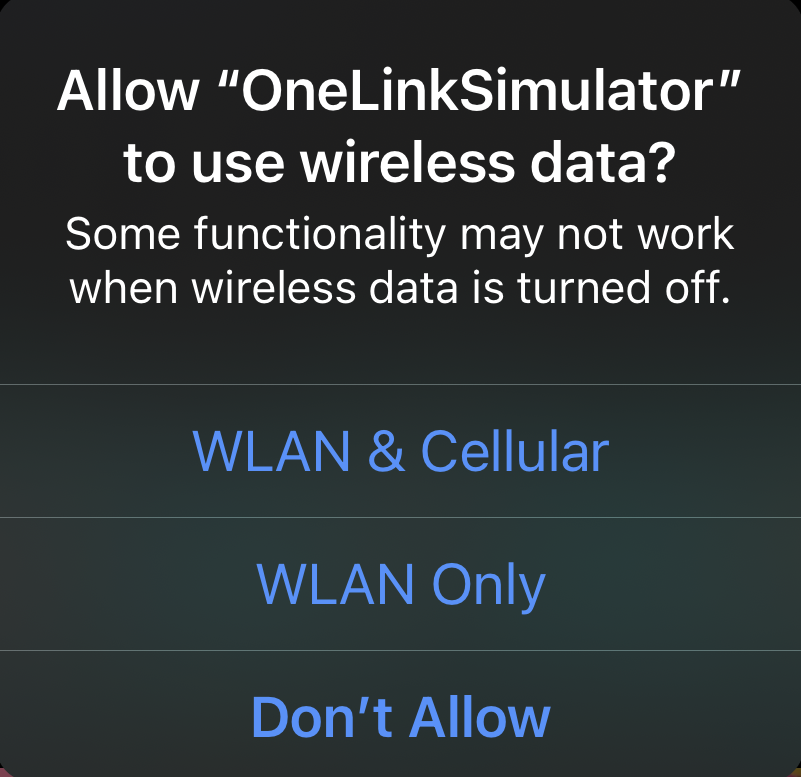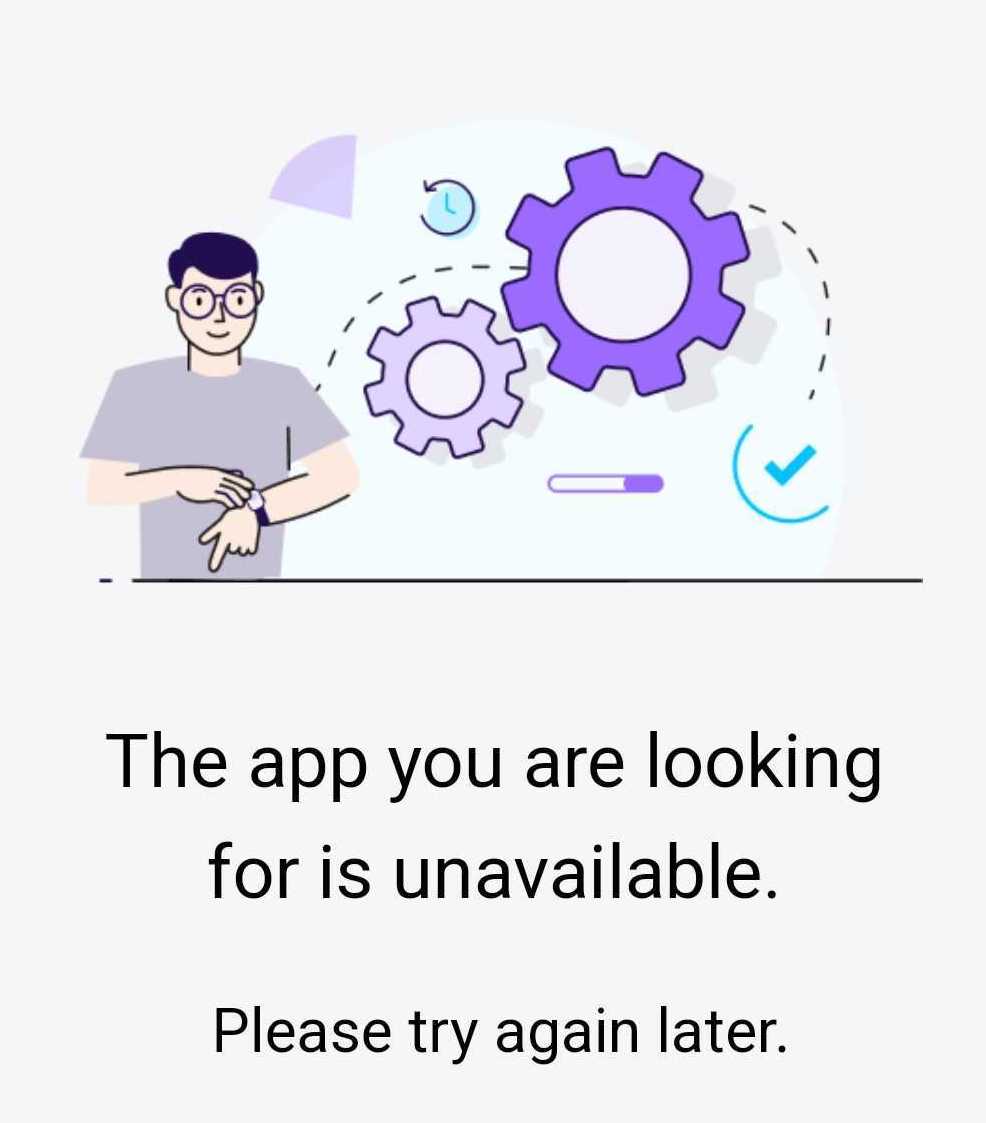iOS Unified Deep Linking
At a glance: Unified deep linking (UDL) enables you to send new and existing users to a specific in-app activity (for example, a specific page in the app) as soon as the app is opened.
UDL privacy protection
For new users, the UDL method only returns parameters relevant to deferred deep linking:
deep_link_valueanddeep_link_sub1-10. If you try to get any other parameters (media_source,campaign,af_sub1-5, etc.), they return null.
Flow

The flow works as follows:
- User clicks a OneLink link.
- If the user has the app installed, the Universal Links or URI scheme opens the app.
- If the user doesn’t have the app installed, they are redirected to the app store, and after downloading, the user opens the app.
- The app open triggers the AppsFlyer SDK.
- The AppsFlyer SDK runs the UDL API.
- The UDL API retrieves OneLink data from AppsFlyer servers.
- The UDL API calls back the
didResolveDeepLink()in theDeepLinkDelegate. - The
didResolveDeepLink()method gets aDeepLinkResultobject. - The
DeepLinkResultobject includes:- Status (Found/Not found/Failure).
- A DeepLink object that carries:
- For users with app not yet installed: The
deep_link_valueanddeep_link_sub1-10parameters. - For users with the app already installed:The
deep_link_valueanddeep_link_sub1-10parameters and all parameters contained in thelinkparameter of the OneLink attribution link.
- For users with app not yet installed: The
Planning
- UDL requires AppsFlyer iOS SDK V6.1+.
When setting up OneLink, the marketer uses parameters to create the links, and the developer customizes the behavior of the app based on the values received. It is the developer's responsibility to make sure the parameters are handled correctly in the app, for both in-app routing, and personalizing data in the link.
To plan the OneLink:
- Get from the marketer the desired behavior and personal experience a user gets when they click the URL.
- Based on the desired behavior, plan the
deep_link_valueand other parameters that are needed to give the user the desired personal experience.- The
deep_link_valueis set by the marketer in the URL and used by the developer to redirect the user to a specific place inside the app. For example, if you have a fruit store and want to direct users to apples, the value ofdeep_link_valuecan beapples. - The
deep_link_sub1-10parameters can also be added to the URL to help personalize the user experience. For example, to give a 10% discount, the value ofdeep_link_sub1can be10.
- The
Implementation

Let's save you some time >>
Set Deep Linking with our SDK integration wizard
Implement the UDL API logic based on the chosen parameters and values.
- Assign the
AppDelegateusingselftoAppsFlyerLib.shared().deepLinkDelegate. - Implement application function to allow:
- Universal Links support with
continue. - URI scheme support with
handleOpen.
- Universal Links support with
- Create
DeepLinkDelegateas an extension ofAppDelegate. - Add
applicationfunctions to support Universal Links and URI schemes. - In
DeepLinkDelegate, make sure you override the callback function,didResolveDeepLink().
didResolveDeepLink()accepts aDeepLinkResultobject as an argument. - Use
DeepLinkResult.statusto query whether the deep linking match is found. - For when the status is an error, call
DeepLinkResult.errorand run your error flow. - For when the status is found, use
DeepLinkResult.deepLinkto retrieve theDeepLinkobject.
TheDeepLinkobject contains the deep linking information arranged in public variables to retrieve the values from well-known OneLink keys, for example,DeepLink.deeplinkValuefordeep_link_value. - Use
deepLinkObj.clickEvent["deep_link_sub1"]to retrievedeep_link_sub1. Do the same fordeep_link_sub2-10parameters, changing the string value as required. - Once
deep_link_valueanddeep_link_sub1-10are retrieved, pass them to an in-app router and use them to personalize the user experience.
Supporting legacy OneLink links
Legacy OneLink links are links that don't contain the parameters recommended for Unified Deep Linking: deep_link_value and deep_link_sub1-10.
Usually these are links that already exist in the field when migrating from legacy methods to UDL.
News users using legacy links are handled by onConversionDataSuccess in the context of extended deferred deep linking.
UDL handles deep linking for existing users. It's recommended that you add support in the UDL callback didResolveDeepLink for legacy parameters.
Swift code example
Code example
func application(_ application: UIApplication, didFinishLaunchingWithOptions launchOptions: [UIApplication.LaunchOptionsKey: Any]?) -> Bool {
// Replace 'appleAppID' and 'appsFlyerDevKey' with your Apple App ID (eg 69999999, without id prefix) and DevKey
// The App ID and the DevKey must be set prior to the calling of the deepLinkDelegate
AppsFlyerLib.shared().appleAppID = appleAppID
AppsFlyerLib.shared().appsFlyerDevKey = appsFlyerDevKey
...
AppsFlyerLib.shared().deepLinkDelegate = self
...
}
// For Swift version < 4.2 replace function signature with the commented out code
// func application(_ application: UIApplication, continue userActivity: NSUserActivity, restorationHandler: @escaping ([Any]?) -> Void) -> Bool { // this line for Swift < 4.2
func application(_ application: UIApplication, continue userActivity: NSUserActivity, restorationHandler: @escaping ([UIUserActivityRestoring]?) -> Void) -> Bool {
AppsFlyerLib.shared().continue(userActivity, restorationHandler: nil)
return true
}
// Open URI-scheme for iOS 9 and above
func application(_ app: UIApplication, open url: URL, options: [UIApplication.OpenURLOptionsKey : Any] = [:]) -> Bool {
AppsFlyerLib.shared().handleOpen(url, options: options)
return true
}
extension AppDelegate: DeepLinkDelegate {
func didResolveDeepLink(_ result: DeepLinkResult) {
var fruitNameStr: String?
switch result.status {
case .notFound:
NSLog("[AFSDK] Deep link not found")
return
case .failure:
print("Error %@", result.error!)
return
case .found:
NSLog("[AFSDK] Deep link found")
}
guard let deepLinkObj:DeepLink = result.deepLink else {
NSLog("[AFSDK] Could not extract deep link object")
return
}
if deepLinkObj.clickEvent.keys.contains("deep_link_sub2") {
let ReferrerId:String = deepLinkObj.clickEvent["deep_link_sub2"] as! String
NSLog("[AFSDK] AppsFlyer: Referrer ID: \(ReferrerId)")
} else {
NSLog("[AFSDK] Could not extract referrerId")
}
let deepLinkStr:String = deepLinkObj.toString()
NSLog("[AFSDK] DeepLink data is: \(deepLinkStr)")
if( deepLinkObj.isDeferred == true) {
NSLog("[AFSDK] This is a deferred deep link")
}
else {
NSLog("[AFSDK] This is a direct deep link")
}
fruitNameStr = deepLinkObj.deeplinkValue
walkToSceneWithParams(fruitName: fruitNameStr!, deepLinkData: deepLinkObj.clickEvent)
}
}
// User logic
fileprivate func walkToSceneWithParams(deepLinkObj: DeepLink) {
let storyBoard: UIStoryboard = UIStoryboard(name: "Main", bundle: nil)
UIApplication.shared.windows.first?.rootViewController?.dismiss(animated: true, completion: nil)
guard let fruitNameStr = deepLinkObj.clickEvent["deep_link_value"] as? String else {
print("Could not extract query params from link")
return
}
let destVC = fruitNameStr + "_vc"
if let newVC = storyBoard.instantiateVC(withIdentifier: destVC) {
print("AppsFlyer routing to section: \(destVC)")
newVC.deepLinkData = deepLinkObj
UIApplication.shared.windows.first?.rootViewController?.present(newVC, animated: true, completion: nil)
} else {
print("AppsFlyer: could not find section: \(destVC)")
}
}
- (BOOL)application:(UIApplication *)application didFinishLaunchingWithOptions:(NSDictionary *)launchOptions {
// Set isDebug to true to see AppsFlyer debug logs
[AppsFlyerLib shared].isDebug = YES;
// Replace 'appsFlyerDevKey', `appleAppID` with your DevKey, Apple App ID
[AppsFlyerLib shared].appsFlyerDevKey = appsFlyerDevKey;
[AppsFlyerLib shared].appleAppID = appleAppID;
[AppsFlyerLib shared].deepLinkDelegate = self;
return YES;
}
- (BOOL)application:(UIApplication *)application continueUserActivity:(NSUserActivity *)userActivity restorationHandler:(void (^)(NSArray * _Nullable))restorationHandler {
[[AppsFlyerLib shared] continueUserActivity:userActivity restorationHandler:nil];
return YES;
}
- (BOOL)application:(UIApplication *)app openURL:(NSURL *)url options:(NSDictionary<UIApplicationOpenURLOptionsKey,id> *)options {
[[AppsFlyerLib shared] handleOpenUrl:url options:options];
return YES;
}
#pragma mark - DeepLinkDelegate
- (void)didResolveDeepLink:(AppsFlyerDeepLinkResult *)result {
NSString *fruitNameStr;
NSLog(@"[AFSDK] Deep link lowkehy");
switch (result.status) {
case AFSDKDeepLinkResultStatusNotFound:
NSLog(@"[AFSDK] Deep link not found");
return;
case AFSDKDeepLinkResultStatusFailure:
NSLog(@"Error %@", result.error);
return;
case AFSDKDeepLinkResultStatusFound:
NSLog(@"[AFSDK] Deep link found");
break;
}
AppsFlyerDeepLink *deepLinkObj = result.deepLink;
if ([deepLinkObj.clickEvent.allKeys containsObject:@"deep_link_sub2"]) {
NSString *referrerId = deepLinkObj.clickEvent[@"deep_link_sub2"];
NSLog(@"[AFSDK] AppsFlyer: Referrer ID: %@", referrerId);
} else {
NSLog(@"[AFSDK] Could not extract referrerId");
}
NSString *deepLinkStr = [deepLinkObj toString];
NSLog(@"[AFSDK] DeepLink data is: %@", deepLinkStr);
if (deepLinkObj.isDeferred) {
NSLog(@"[AFSDK] This is a deferred deep link");
if (self.deferredDeepLinkProcessedFlag) {
NSLog(@"Deferred deep link was already processed by GCD. This iteration can be skipped.");
self.deferredDeepLinkProcessedFlag = NO;
return;
}
} else {
NSLog(@"[AFSDK] This is a direct deep link");
}
fruitNameStr = deepLinkObj.deeplinkValue;
// If deep_link_value doesn't exist
if (!fruitNameStr || [fruitNameStr isEqualToString:@""]) {
// Check if fruit_name exists
id fruitNameValue = deepLinkObj.clickEvent[@"fruit_name"];
if ([fruitNameValue isKindOfClass:[NSString class]]) {
fruitNameStr = (NSString *)fruitNameValue;
} else {
NSLog(@"[AFSDK] Could not extract deep_link_value or fruit_name from deep link object with unified deep linking");
return;
}
}
// This marks to GCD that UDL already processed this deep link.
// It is marked to both DL and DDL, but GCD is relevant only for DDL
self.deferredDeepLinkProcessedFlag = YES;
[self walkToSceneWithParams:fruitNameStr deepLinkData:deepLinkObj.clickEvent];
}
- (void)walkToSceneWithParams:(NSString *)fruitName deepLinkData:(NSDictionary *)deepLinkData {
UIStoryboard *storyboard = [UIStoryboard storyboardWithName:@"Main" bundle:nil];
[[UIApplication sharedApplication].windows.firstObject.rootViewController dismissViewControllerAnimated:YES completion:nil];
NSString *destVC = [fruitName stringByAppendingString:@"_vc"];
DLViewController *newVC = [storyboard instantiateViewControllerWithIdentifier:destVC];
NSLog(@"[AFSDK] AppsFlyer routing to section: %@", destVC);
newVC.deepLinkData = deepLinkData;
[[UIApplication sharedApplication].windows.firstObject.rootViewController presentViewController:newVC animated:YES completion:nil];
}
⇲ Github links: Swift
⇲ Github links: Objective-C
Deferred Deep Linking after network consent
In some cases the application might require consent from the user in order to connect to the network, in a dialog similar to this one:

In order to support deferred deep linking once the network consent is given we recommend:
- Implement eDDL to allow UDL to handle the deferred deep linking
Testing deferred deep linking
Prerequisites
- Complete UDL integration.
- Register your testing device.
- Enable debug mode in the app.
- Make sure the app isn't installed on your device.
- Ask your marketer for a OneLink template.
- It will look something like this
https://onelink-basic-app.onelink.me/H5hv. - This example uses the OneLink subdomain
onelink-basic-app.onelink.meand the OneLink template IDH5hv.
- It will look something like this
The test link
You can use an existing OneLink link or ask your marketer to create a new one for testing. Both short and long OneLink URLs can be used.
Adding ad-hoc parameters to an existing link
- Use only the domain and OneLink template of your link. For example:
https://onelink-basic-app.onelink.me/H5hv. - Add OneLink parameters
deep_link_valueanddeep_link_sub1-10as expected by your application. The parameters should be added as query parameters.- Example:
https://onelink-basic-app.onelink.me/H5hv?pid=my_media_source&deep_link_value=apples&deep_link_sub1=23
- Example:
Perform the test
- Click the link on your device.
- OneLink redirects you according to the link setup, to either the App Store or a website.
- Install the application.
Important
- If the application is still in development and not uploaded to the store yet, you see this image:

- Install the application from Xcode.
- If the application is still in development and not uploaded to the store yet, you see this image:
- UDL detects the deferred deep linking, matches the install to the click, and retrieves the OneLink parameters to
didResolveDeepLinkcallback.
Expected logs results
The following logs are available only when debug mode is enabled.
- SDK initialized:
[AppsFlyerSDK] [com.apple.main-thread] AppsFlyer SDK version 6.6.0 started build - UDL API starts:
D/AppsFlyer_6.9.0: [DDL] start - UDL sends query to AppsFlyer to query a match with this install:
[AppsFlyerSDK] [com.appsflyer.serial] [DDL] URL: https://dlsdk.appsflyer.com/v1.0/ios/id1512793879?sdk_version=6.6&af_sig=efcecc2bc95a0862ceaa7b62fa8e98ae1e3e022XXXXXXXXXXXXXXXX - UDL got a response and calls
didResolveDeepLinkcallback withstatus=FOUNDand OneLink link data:[AppsFlyerSDK] [com.appsflyer.serial] [DDL] Calling didResolveDeepLink with: {"af_sub4":"","click_http_referrer":"","af_sub1":"","click_event":{"af_sub4":"","click_http_referrer":"","af_sub1":"","af_sub3":"","deep_link_value":"peaches","campaign":"","match_type":"probabilistic","af_sub5":"","campaign_id":"","media_source":"","deep_link_sub1":"23","af_sub2":""},"af_sub3":"","deep_link_value":"peaches","campaign":"","match_type":"probabilistic","af_sub5":"","media_source":"","campaign_id":"","af_sub2":""}
Testing deep linking (Universal Links)
Prerequisites
- Complete UDL integration.
- Register your testing device.
- Enable debug mode in the app.
- Make sure the app is already installed on your device.
- Ask your marketer for a OneLink template.
- It will look something like this
https://onelink-basic-app.onelink.me/H5hv. - This example uses the OneLink subdomain
onelink-basic-app.onelink.meand the OneLink template IDH5hv
- It will look something like this
- Configure Universal Links.
Create the test link
Use the same method as in deferred deep linking.
Perform the test
- Click the link on your device.
- UDL detects the Universal Link and retrieves the OneLink parameters to
didResolveDeepLinkcallback.
Expected logs results
The following logs are available only when debug mode is enabled.
- If the link is a OneLink shortlink (e.g. https://onelink-basic-app.onelink.me/H5hv/apples):
[AppsFlyerSDK] [com.apple.main-thread] NSUserActivity `webpageURL`: https://onelink-basic-app.onelink.me/H5hv/apples [AppsFlyerSDK] [com.appsflyer.serial] UniversalLink/Deeplink found: https://onelink-basic-app.onelink.me/H5hv/apples [AppsFlyerSDK] [com.appsflyer.serial] Shortlink found. Executing: https://onelink.appsflyer.com/shortlink-sdk/v2/H5hv?id=apples ... [AppsFlyerSDK] [com.appsflyer.serial] [Shortlink] OneLink:{ c = test1; campaign = test1; "deep_link_sub1" = 23; "deep_link_value" = peaches; "is_retargeting" = true; "media_source" = SMS; pid = SMS; } - UDL calls
didResolveDeepLinkcallback withstatus=FOUNDand OneLink link data:[AppsFlyerSDK] [com.appsflyer.serial] [DDL] Calling didResolveDeepLink with: {"af_sub4":null,"click_http_referrer":null,"af_sub1":null,"click_event":{"campaign":"test1","deep_link_sub1":"23","deep_link_value":"peaches","media_source":"SMS"},"af_sub3":null,"deep_link_value":"peaches","campaign":"test1","match_type":null,"af_sub5":null,"media_source":"SMS","campaign_id":null,"af_sub2":null}
Updated about 1 month ago